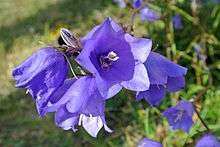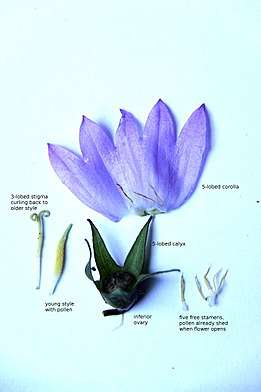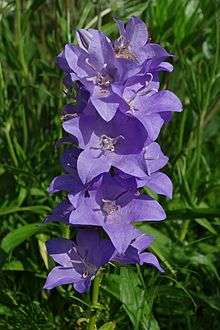Campanula
- For the main belt asteroid, see 1077 Campanula. The hydrozoan genus Campanula is usually included in Campanularia today.
| Bellflower | |
|---|---|
 | |
| Campanula persicifolia near Tehumardi, Saaremaa, Estonia. | |
| Scientific classification | |
| Kingdom: | Plantae |
| (unranked): | Angiosperms |
| (unranked): | Eudicots |
| (unranked): | Asterids |
| Order: | Asterales |
| Family: | Campanulaceae |
| Subfamily: | Campanuloideae |
| Genus: | Campanula L.[1] |
| Type species | |
| Campanula latifolia L.[2] | |
| Synonyms[3] | |
|
List
| |
Campanula /kæmˈpæn.juːlə/[4] is one of several genera in the family Campanulaceae with the common name bellflower. It takes both its common and its scientific name from its bell-shaped flowers—campanula is Latin for "little bell".
The genus includes over 500 species and several subspecies, distributed across the temperate and subtropical regions of the Northern Hemisphere, with the highest diversity in the Mediterranean region east to the Caucasus.[5] The range also extends into mountains in tropical regions of Asia and Africa.[3]
The species include annual, biennial and perennial plants, and vary in habit from dwarf arctic and alpine species under 5 cm high, to large temperate grassland and woodland species growing to 2 metres (6 ft 7 in) tall.
Description

The leaves are alternate and often vary in shape on a single plant, with larger, broader leaves at the base of the stem and smaller, narrower leaves higher up; the leaf margin may be either entire or serrated (sometimes both on the same plant). Many species contain white latex in the leaves and stems.[6]
The flowers are produced in panicles (sometimes solitary), and have a five-lobed corolla, typically large (2–5 cm or more long), mostly blue to purple, sometimes white or pink. Below the corolla, 5 leaf-like sepals form the calyx. Some species have a small additional leaf-like growth termed an "appendage" between each sepal, and the presence or absence, relative size, and attitude of the appendage is often used to distinguish between closely related species.[6]
The fruit is a capsule containing numerous small seeds.[6]
Campanula species are used as food plants by the larvae of some Lepidoptera species including Common Pug (recorded on Harebell), Dot Moth, Ingrailed Clay (recorded on Harebell), Lime-speck Pug and Mouse Moth.
Cultivation and uses
Well-known species include the northern temperate Campanula rotundifolia, commonly known as harebell in England and bluebell in Scotland and Ireland (though it is not closely related to the true bluebells), and the southern European Campanula medium, commonly known as Canterbury bells (a popular garden plant in the United Kingdom). As well as several species occurring naturally in the wild in northern Europe, there are many cultivated garden species.
The cultivars 'Burghaltii'[7] and 'Kent Belle'[8] have gained the Royal Horticultural Society's Award of Garden Merit.
The species Campanula rapunculus, commonly known as rampion bellflower, rampion, or rover bellflower, is a biennial vegetable which was once widely grown in Europe for its spinach-like leaves and radish-like roots.[9] The Brothers Grimm's tale Rapunzel took its name from this plant.
In the UK the National Collection of campanulas is held at Burton Agnes Hall in East Yorkshire and the National Collection of Alpine Campanulas at Langham Hall in Suffolk.
Related genera
The classification of some Campanulaceae genera as either part of Campanula or separate genera can vary by system, including Azorina, Campanulastrum, Canarina, Edraianthus, Musschia, Ostrowskia, and Platycodon. Some genera previously not segregated from Campanula currently are segregated in some systems, including Annaea, Gadellia, and Theodorovia. Hemisphaera was formerly Campanula, subsect. Scapiflorae, and Neocodon was Campanula sect. Rapunculus.[10]
Species

There are 473, including:
|
|
Formerly placed here
- Adenophora gmelinii (Spreng.) Fisch. (as C. coronopifolia Schult. or C. gmelinii Spreng.)
- Adenophora khasiana (Hook.f. & Thomson) Collett & Hemsl. (as C. khasiana Hook.f. & Thomson)
- Adenophora liliifolia (L.) Besser (as C. liliifolia L.)
- Adenophora triphylla (Thunb.) A.DC. (as C. tetraphylla Thunb. or C. triphylla Thunb.)
- Azorina vidalii (H.C.Watson) Feer (as C. vidalii H.C.Watson)
- Borago pygmaea (DC.) Chater & Greuter (as C. pygmaea DC.)
- Legousia pentagonia (L.) Druce (as C. pentagonia L.)
- Legousia speculum-veneris (L.) Durande ex Vill. (as C. speculum-veneris L.)
- Platycodon grandiflorus (Jacq.) A.DC. (as C. glauca Thunb. or C. grandiflora Jacq.)
- Triodanis perfoliata (L.) Nieuwl. (as C. perfoliata L.)
- Wahlenbergia linarioides (Lam.) A.DC. (as C. linarioides Lam.)
- Wahlenbergia marginata (Thunb.) A.DC. C. gracilis G.Forst. or C. marginata Thunb.)
- Wahlenbergia undulata (L.f.) A.DC. (as C. undulata L.f.)[11]
Chemistry
Violdelphin is an anthocyanin, a type of plant pigments, found in the blue flowers in the genus Campanula.[12]
References
- ↑ "Genus: Campanula L.". Germplasm Resources Information Network. United States Department of Agriculture. 2004-01-29. Retrieved 2011-02-03.
- ↑ lectorype designated by Britton & Brown, Illustrated Flora of the Northern United States (ed. 2) 3: 294 (1913)
- 1 2 Kew World Checklist of Selected Plant Families
- ↑ Sunset Western Garden Book, 1995:606–607
- ↑ Altervista Flora Italiana, Genere: Campanula - Famiglia: Campanulaceae
- 1 2 3 Flora of China, v 19 p 530, 风铃草属 feng ling cao shu, Campanula Linnaeus, Sp. Pl. 1: 163. 1753.
- ↑ "RHS Plant Selector - Campanula 'Burghaltii'". Retrieved 21 June 2013.
- ↑ "RHS Plant Selector - Campanula 'Kent Belle'". Retrieved 21 June 2013.
- ↑
 Rines, George Edwin, ed. (1920). "Rampion". Encyclopedia Americana.
Rines, George Edwin, ed. (1920). "Rampion". Encyclopedia Americana. - ↑ Tatyana V. Shulkina, John F. Gaskin and W. M. M. Eddie, "Morphological Studies toward an Improved Classification of Campanulaceae s. str.," Annals of the Missouri Botanical Garden 90.4 (2003), pp. 578, 583.
- ↑ "GRIN Species Records of Campanula". Germplasm Resources Information Network. United States Department of Agriculture. Retrieved 2011-02-03.
- ↑ Structure and biosynthesis of anthocyanins in flowers of Campanula. Kirsten Brandt, Tadao Kondo, Hideki Aoki and Toshio Goto, Phytochemistry, 29 April 1993, Volume 33, Issue 1, Pages 209–212, doi:10.1016/0031-9422(93)85424-P
- Fitter, R; A Fitter (1974). The Wild Flowers of Britain and Northern Europe. Collins.
External links
| Wikimedia Commons has media related to Campanula. |
| Wikispecies has information related to: Campanula |